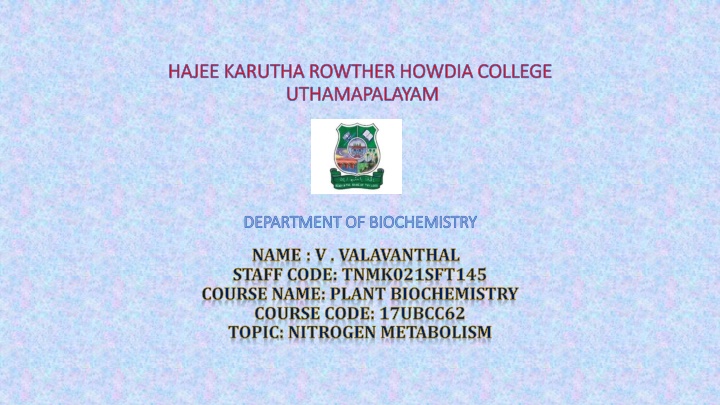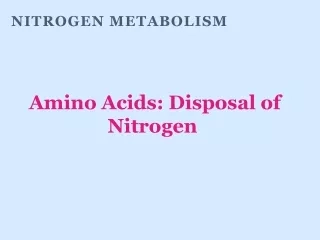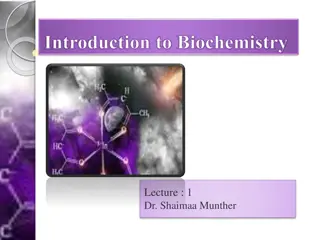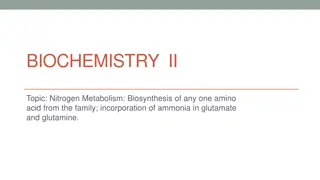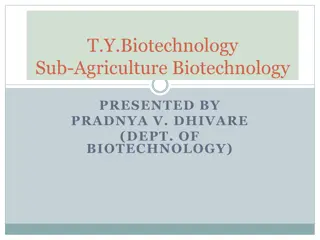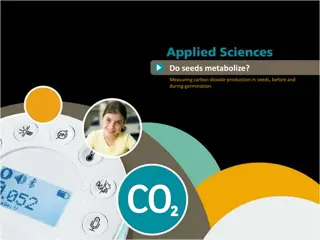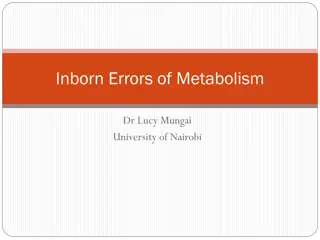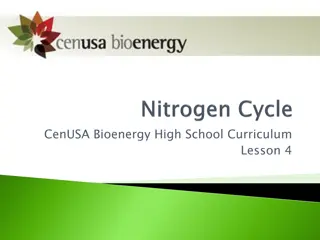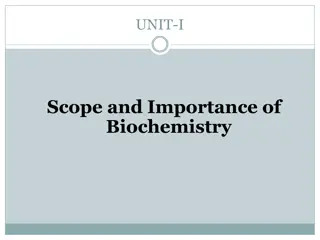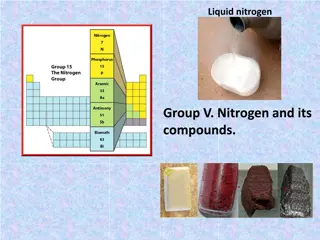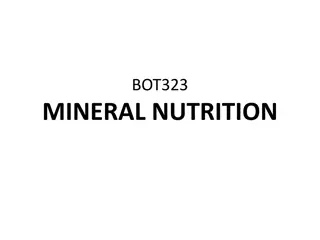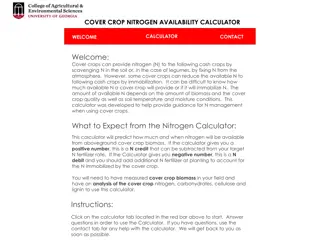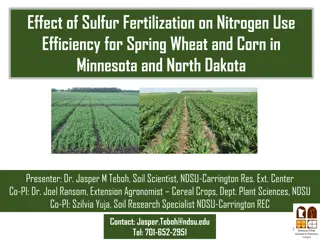The Role of Nitrogen in Plant Biochemistry: Understanding Nitrogen Metabolism
Nitrogen is a crucial element in plant biochemistry, essential for protein synthesis and the formation of various organic compounds. This article explores the sources of nitrogen available to plants, including atmospheric nitrogen, nitrates, and organic nitrogen compounds. The importance of nitrogen in plant growth, metabolism, and reproduction is highlighted, shedding light on the intricate process of converting inorganic nitrogen into organic forms within plant cells.
Uploaded on Sep 29, 2024 | 2 Views
Download Presentation

Please find below an Image/Link to download the presentation.
The content on the website is provided AS IS for your information and personal use only. It may not be sold, licensed, or shared on other websites without obtaining consent from the author.If you encounter any issues during the download, it is possible that the publisher has removed the file from their server.
You are allowed to download the files provided on this website for personal or commercial use, subject to the condition that they are used lawfully. All files are the property of their respective owners.
The content on the website is provided AS IS for your information and personal use only. It may not be sold, licensed, or shared on other websites without obtaining consent from the author.
E N D
Presentation Transcript
HAJEE KARUTHA ROWTHER HOWDIA COLLEGE HAJEE KARUTHA ROWTHER HOWDIA COLLEGE UTHAMAPALAYAM UTHAMAPALAYAM DEPARTMENT OF BIOCHEMISTRY DEPARTMENT OF BIOCHEMISTRY NAME : V . VALAVANTHAL STAFF CODE: TNMK021SFT145 COURSE NAME: PLANT BIOCHEMISTRY COURSE CODE: 17UBCC62 TOPIC: NITROGEN METABOLISM
NITROGEN METABOLISM Nitrogen is a universally occurring element in all the living beings. Apart from water and mineral salts the next major substance in plant cell is protein (about 10-12 % of the cell).These proteins which are building blocks of the protoplasm are made up of nitrogenase substances called as the amino acid which in turn are synthesized when inorganic nitrogen of the environment is converted into organic nitrogen inside the plants. (plant cells are therefore, unique in their ability to convert inorganic nitrogen into organic nitrogen). Nitrogen is also constituent element of many other important organic compounds like chlorophylls,cytochromes,alkaloids,many vitamins (which serve as a functional groups of many enzymes) and above all of nucleic acid and thus plays a very important and fundamental role in metabolism,growth,reproduction,and heredity.
SOURCES OF PLANTS TO PLANTS (1) Atmospheric Nitrogen (Molecular Nitrogen) Although about 78 % of the earth's atmosphere is composed of nitrogen, the majority of the plants can not utilise this from of nitrogen. Only some bacteria, some blue-green algae, leguminous plants (having root nodules) etc. can fix atmospheric nitrogen. (2) Nitrates, Nitrites, Ammonia in the soil (Inorganic Nitrogen) Among these, the nitrate is the chief form of nitrogen taken up by the plants from the soil.
(3) Amino Acids (Organic Nitrogen) in the soil many soil micro-organisms make use of this from of nitrogen. Sometimes it may also be taken by higher plants. (4)Organic Nitrogenous Compounds in Bodies of the Insects Insectivorous plants requirement by catching the small insects and digesting them. fulfil their nitrogen
INTRODUCTION INTRODUCTION The plants in order to flower require a certain day length i.e., the relative length of day night which night is called as photoperiod. The response of the photoperiod expressed in the from of flowing is called as photoperiodism. The phenomenon of photoperiodism was first discovered by Garner and Allard (1920,22) who observed that the Biloxi verity of soya bean (glycine max) and Maryland mammoth variety of tobacco (Nicotiana tabacum) could be made to flower only when the daily exposure to the light was reduced below a certain critical duration and after many complex experiments conclude that the relative length of day is a factor of the first importance in the growth and development of plant. Depending upon the duration of the photoperiod, they classified plant into three categories.
(1)SHORT DAY PLANTS (SDS) (1)SHORT DAY PLANTS (SDS) These plants require a relatively short day period (usually 8-10 hours)and a continuous dark period of about 14-16 hours for subsequent flowering. Some example of these plant which are also known as long-night-plants are Maryland Mammoth variety of tobacco (nicotiana tabacum)Biloxi verity of soybeans (glycine max), cocklebur (Xanthium pennsylvanicum). In short day plant the dark period is critical and must be continuous. If this dark period is interrupted even with a brief exposure of red light (660-665 m? wavelength ),the short day plant will not flower.
Maximum inhibition of flowing with red light occurs at about the middle of critical dark period. However, the inhibitory effect of red light can be overcomes by a subsequent exposure with far-red light (730-735 m? wavelength). Interruption of the light period with red light does not have inhibitory effect on flowering in short day plants. Prolongation of the continuous dark period initiates early flowering in short day plants. (2)LONG DAY PLANTS (LDP) (2)LONG DAY PLANTS (LDP) These plants require a longer day light period usually 14-16 hours) in a 24 hours continuous exposure. Some of the examples of these plants which are also called as short night plants are Hyoscyamus niger (Henbane)spinae (spinach) Beta vulgaris (sugar beet).
In long day plant the light period is critical. A brief exposure in the dark period or the prolongation of the light period stimulates flowing in long day plants. (3)DAY NEUTRAL PLANTS These plants flower in all photoperiod ranging from 5 hours to 24 hours continuous exposure. Some of the example of these plants are tomato, cotton, sunflower, cucumber and certain varieties of peas and tobacco. during recent years certain intermediate categories of plants have also been recognised. There are, Long Long Short Short Day Day Plants Plants: : These are short day plants but must be exposed to long days during early period of growth for subsequent flowering. Some of the example of plants are certain species of Bryophyllum.
Short Short- -Long Long Day These are long day plants but must be exposed to short days during early period of growth for subsequent flowering. some of the example of these plants are certain varieties of wheat (Triticum) and rye (Secale). PHOTOPERIODIC INDUCTION PHOTOPERIODIC INDUCTION Plants may require one or more inductive cycles for flowering. An appropriate photoperiod in 24 hours cycle constitutes one inductive cycle. If a plant which has receive d sufficient inductive cycles is subsequently placed under unfavourable photoperiods, it photoperiods (i.e., discontinuous inductive cycles). This persistence of photoperiod photoperiodic induction. Day Plants Plants: : will still flower. Flowering after effect is called as
An increase in the number of inductive cycles result in early flowering of the plant for instance Xanthium in the (a short day plant).requires only one inductive cycle and normally flowers after about 64 days. It can be made to flower even after 13 days if it has received 4-8 inductive cycles. In such cases the number of flowers is also increased. Continuous inductive cycles discontinuous inductive cycles. Some of the example of plants which require more than one inductive cycles for subsequent flowering are Biloxi soybean (SDP) -2 inductive cycle cycles; salvia occidentalis (SDP)-17 inductive cycles; Plantago Lanceolata (LDP)-25 inductive cycles. promote early flowering than
It is now well established that the photoperiodic stimulus is perceived by the leaves. As a result, a floral hormone is produced in the leaves which Is then translocated to the apical tip, subsequently causing the initiation of floral primordia. That the photoperiodic stimulus is perceived by the leaves can be shown by simple experiments pennsylvanicum), a short day plant. Cocklebur plant will flower if it has previously been kept under short-day conditions. If the plant is defoliated and then kept under short day condition, it will not flower. Flowering will also occur even if all the leaves of the except one leaf have been removed. (Xanthium on cocklebur
If a cocklebur plant whether intact of defoliated, is kept under long conditions it will not flower. But, If even one of its leaves is exposed to short day condition and the rest are under long day photoperiods, flowering will occur. The photoperiodic, stimulus can be transmitted from one branch of the plant to another branch. For example, if in a two branched cocklebur plant one branch is exposed to short day and other to long day photo period, flowering occurs on both the branches. Flowering also occurs if one branch is kept under long day conditions and other branch from which all the leaves except one have been removed is exposed to short day conditions . However ,if one branch is exposed to long photoperiod and the other has been defoliated under short day condition. Flowering will not occur in any of the branches.
Nature of the Floral hormone Although there are firm evidences for the existence of a floral hormone but it has not yet been isolated. Therefore, the nature of this hormone which has been named as Florigen is not very clear. But it is quite evident that this hormone is a material substance which can be translocated from leaves to the apical tips situated at other parts of the plant resulting in flowering. Grafting experiments in cocklebur plants have even proved that the floral hormone can be translocated from one plant to another. For example, if one branched cocklebur plant. Which has been exposed to short day conditions, flowering occur on both the plants. Obviously the floral hormone has been transmitted to the receptor plant thought graft union. But if a cocklebur plant is grafted to another similar plant both of which have been kept under long day ,flowering will not occur on either of the two plants.
It has also been indicated that the floral hormone may be identical in short-day and long-day plants for example, grafting experiments between certain long-day plant and short-day plants have shown that flowering occurs on both the plants even if one of them has been a under non-inductive photoperiods.
REFERANCE: Plant Biochemistry by Ross and Salisburry Plant Biochemistry by Bonner and Vamer, 3rdedition, acadmic press.
